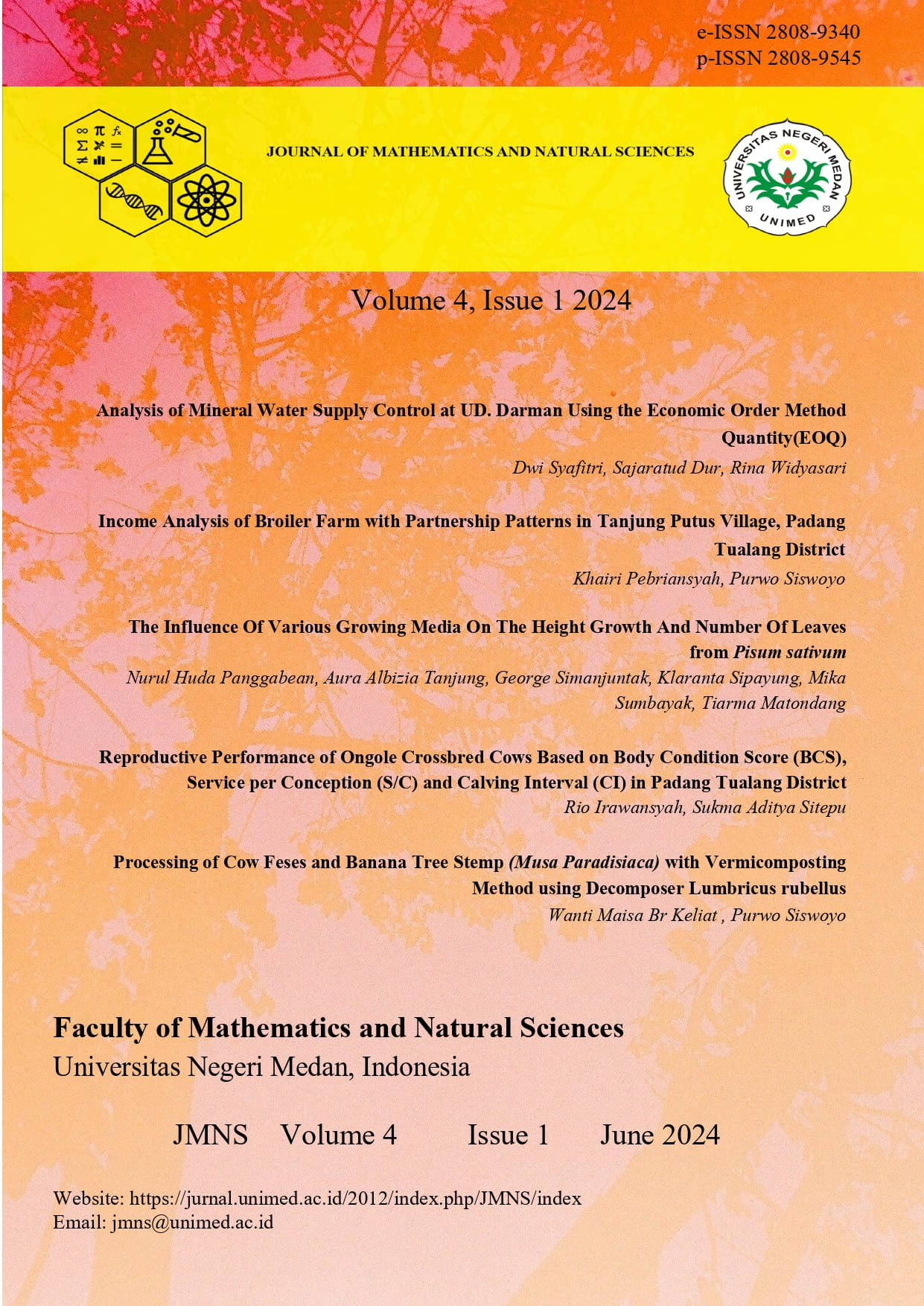Processing of Cow Feses and Banana Tree Stemp (Musa Paradisiaca) with Vermicomposting Method using Decomposer Lumbricus rubellus
DOI:
https://doi.org/10.24114/jmns.v4i1.62554Abstract
Vermicompost is the result of the decomposition of organic materials by earthworms, producing fermented worm castings. In addition to the texture and moisture content of the organic material, temperature and pH also play crucial roles in determining the efficiency of the decomposers, leading to optimal vermicompost production. This study aims to evaluate the processing of cow manure and banana tree stems using the decomposer Lumbricus rubellus with the vermicomposting method. The study also hopes to reduce environmental pollution and provide value from livestock and agricultural waste management activities. The research employed a Completely Randomized Design (CRD) with five treatments and four replications. Cow manure and banana tree stems were used as the main materials with different formulations for each treatment. The study results indicated that the temperature values of vermicompost in each treatment showed no significant differences (p>0.05) across all treatments, the pH values of vermicompost in each treatment also showed no significant differences (p>0.05) across all treatments and the production of vermicompost showed significant differences (p<0.05) across all treatments. Treatment P3 had the highest vermicompost production value at 1462.5 g, with a waste degradation rate of 46%. The processing of cow feses and banana tree stems has potential as a raw material for vermicompost production.References
Arif, S., Triastuti R., Mukhlissual F. (2007). Pemanfaatan Limbah Tomat Sebagai Pengganti EM-4 pada proses Pengomposan Sampah Organik, Jurnal Penelitian Sains & Teknologi. 8(2), 128
Aziez, A.F., Budiyono, A. (2018). Vermikompos, Pestisida Dan Pupuk Organik Cair Berbasis Kearifan Lokal.
Djaja, W. (2008). Langkah Jitu Membuat Kompos dari Kotoran Ternak dan Sampah. Jakarta: Agro Media Pustaka.
Djuarnani, N., Kristiani., Setiawan, B.S. (2008). Cara Cepat Membuat Kompos. Jakarta: Agromedia Pustaka.
Dwiyantono, R., Sutaryo., Purnomoadi, A. (2014). Perbandingan Kualitas Vermikompos Yang Dihasilkan Dari Feses Sapi Dan Kerbau. Animal Agriculture Journal. 3(2): 147-154.
Gaddie, SRRE., Douglas D.E. (1977). Earthworms For Ecology and Profit: Scientific Earthworm Farming, Vol. I. California: Bookworms Publishing Company.
Hazra, F., Dianisa, N., Widyastuti, R. (2018). Kualitas Dan Produksi Vermikompos Menggunakan Cacing Afrikan Night Crawler (Eudrilus Euganinae). Jurnal Ilmu Tanah dan Lingkungan. 20(2): 77-81.
Liptan. (2017). Pertanian Organik. Balai Pengkajian Teknologi Pertanian (BPTP).
Mashur. (2001). Vermikompos Pupuk Organik Berkualitas dan Raah Lingkungan. Instalasi Penelitian dan Pengkajian Teknologi Pertanian dan Pengembangan Pertanian.
Nisa , K. (2016). Memproduksi Kompos Dan Mikro Organisme Lokal (MOL). Jakarta: Bibit Publisher.
Parmelee, R.W., M.H. Beare, W. Cheng, P.F. Hendrix, S.J. Rider, D.A. Crossley., D.C. Coleman. (1990). Earthworm And Enchytraeids in Conventional and No Tillage Agroecosystems: A Biocide Approach to Asses Their Role in Organic Matter Breakdown. Biology Fertility Soils, 10: 1“10.
Patanga N., Yuliarti N. (2016). Pembuatan Aplikasi Dan Bisnis Pupuk Organik Dari Limbah Pertanian Peternakan Dan rumah Tangga. Jakarta: Gramedia.
Priyati, S.A., Suwondo, Dan Wulandari, S. (2023). Pengaruh Lama Fermentasi Dengan Bioaktivator Em4 Terhadap Kandugan N dan C/N Pupuk Bokashi Ampas Tebu (Saccharum Officinarum L). Jom Fkip. 10(1): 5-9
Purnomo, E., Sutrisno, E., Sumiyati.S. (2017). Pengaruh Variasi C/N Rasio Terhadap Produksi Kompos Dan Kandungan Kalium (K), Pospat (P) Dari Batang Pisang Dengan Kombinasi Kotoran Sapi Dalam Sistem Vermicomposting. Jurnal Teknik Lingkungan. 6(2): 1-15.
Putra, H. K., Rahayu, N., dan Kusmayadi, A. (2022). Pengolahan Feses San Limbah Kol Dengan Metode Vermokompos Menggunakan Dekomposer Lumbricus Rubellus Ditinjau Dari Ph, Suhu, Dan Produksi Vermikompos. Jurnal Ilmu Pertanian Dan Peternakan. 10(2): 245-28.
Rohim, A.M., Napoleon, A., Imanuddin, M.S. Rossa, S. (2011). Pengaruh Vermikompos terhadap Perubahan Kemasaman (pH) dan P-tersedia Tanah. Universitas Sriwijaya.
Roslim, D.I., Herman. (2013). Karakter Morfologi Dan Pertumbuhan Tiga Jenis Cacing Tanah Lokal Pekanbaru Pada Dua Macam Media Pertumbuhan. Biosaintifika. 5(1): 6-7.
Sinha, R.K., (2009). Earthworms Vermicompost: A Powerful Crop Nutrient over the Conventional Compost and Protective Soil Conditioner againts the Destructive Chemical Fertilizers for Food Safety and Security. Am-Euras. J. Agric.and Environ. Sci. Vol.5: 1-55.
Tallo, M. L.L. dan Sio, S. (2019). Pengaruh Lama Fermentasi Terhadap Kualitas Pupuk Bokashi Padat Kotoran Sapi. Journal Of Animal Science. 4(1): 12-14.

